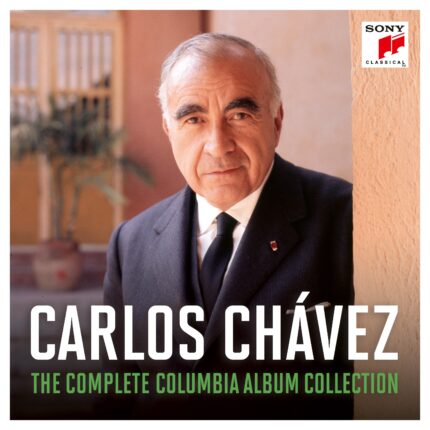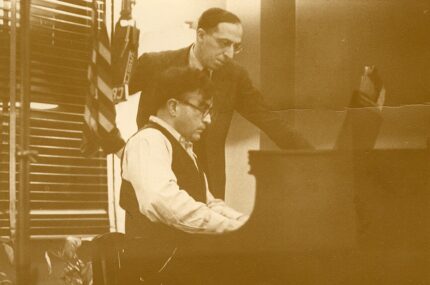Carlos Chávez receives his belated due with Sony box set

Carlos Chávez: The Complete Columbia Album Collection (Sony 7-CD box)
The major classical labels have been digging into their archives in recent years to release a staggering number of comprehensive box sets and retrospectives. One of the most intriguing is a recent Sony box, which contains all of the recordings that Carlos Chávez made for Columbia (the forerunner of Sony). Most of these recordings have never before been released on CD.
Chávez (1899-1978) was Mexico’s greatest classical composer, a close friend of Aaron Copland who premiered his colleague’s El Salon Mexico. Chávez had an individual voice, one which often fused Mexican folk strains and instrumental sonorities with his own brand of bristling energy, lean lyricism and an often-astringent style. Chávez enjoyed a busy career in his lifetime as working conductor as well as composer, which is reflected in this seven-disc set.
The heart of the collection are Chávez’s six symphonies, recorded in 1966 with the Orquesta Sinfonico Nacional de Mexico and conducted by the composer.
Chávez’s Sinfonia India (No. 2) is his most performed music, a flavorful single-movement work influenced by Mexican folk music, which receives a lively and rousing performance. His first attempt in the genre, Sinfonia de Antigona, reworked incidental music for a stage production of Antigone, and its compelling modal harmonies give it a hard-edged Stravinskian feel.
The Symphony No. 3 is on a larger scale, cast in four attacca movements. The opening movement almost suggests Copland’s 1920s brutalist phase with its harsh, jagged opening and lyrical second theme. The inner movements are bumptious and playful by turns and the Third concludes in a darkly brooding finale, with searching expression alternating with pounding timpani and an emphatic coda. This uncompromising piece may be Chávez’s masterwork in the genre.
The Symphony No. 4 (“Sinfonia romantica”) is similarly sharp-edged but also more lyrical at times with free wind writing, and a yearning theme in the slow movement, which lives up to the subtitle. The work ends in a rambunctious finale, though the garrulous movement goes on rather long for its slight material.
The Symphony No. 5 for Strings is a restless, motoric work with an angular lyricism and somewhat crazed conclusion. Symphony No. 6, Chávez’s final work in the genre is his largest in scale, spanning 32 minutes (in his usual three movements). The piece almost feels like a compendium of Chávez’s preceding symphonies: the first movement driving and edgy, a brief melancholy slow movement with trumpet and wind solos. The 15-minute finale is another energized closer, which at time looks back on the Stravinskyian Neoclassicism of his First Symphony. The music has a slow-moving gravitas, which builds inexorably to a hard-won yet affirmative coda.

Equally compelling is Chávez’s underrated Violin Concerto, cast in a palindromic structure. Henryk Szeryng is a world-class advocate for this work and his gleaming, acutely focused tone instantly compels attention. The sonata-style opening movement alternates a fast allegro with lyrical rumination and a lovely horn solo near the end of movement. The Scherzo offers a capricious theme and variations, followed by an extended central cadenza and a brooding, large-scale finale that works its way to a fizzing virtuosic finale. With superb conducting by the composer, Szeryng brings great sympathy to this unorthodox work and his communicative performance makes the finest possible case for this music.
Chávez’s Soli for chamber groupings are represented with three excerpts. Soli I (for winds) is engaging if epigrammatic and the stark Soli IV (for brass trio) is not among his more timeless pieces. The longest and best of the three is Soli II for wind quintet, which has greater thematic invention and more space in five movements to create a compelling musical argument.
The final disc contains music from two of Chávez’s ballets, which bring some of his most characteristic and fascinating efforts. In the two final acts from Pirámide, “The Elements” shows Chávez’s at his most modernistic and astringent: jagged lines for the Wind, Water represented by pointillist pizzicatos, and Stravinsky-like low winds for Fire. The concluding General Dance, with an extended folk-flavored a cappella section for chorus, suggests a Latin Rite of Spring as the music grows increasingly complex and discordant.
The ballet Los cuatro soles is heard complete. The scenario involves the four suns of the title, which paint different epochs of the ancient Nahua people, each era of which was destroyed by a different natural catastrophe. Here, one feels Chavez successfully blending the Mexican folk influence with his own edgy compelling style in the exuberant chaos of this 28-minute ballet, very well played by the London Symphony Orchestra.
The box also include Chávez’s recordings of Mexican folk songs (arranged by himself and others) and shorter Chávez works, including two recordings of his popular arrangement of Buxtehude’s Chaconne in E minor and early mono recordings of the first two symphonies.
The recordings date from 1938 to 1973 and come up well in this remastering. The only caveat is the documentation in the colorful booklet, which has only a general note about Chávez, and facile passing references to the musical works herein. For such an important reissue, Sony could have easily replaced some of the seven pages of photos and Mexican artwork with more details on the actual music.
That not-insignificant lapse apart, this reissue of Carlos Chávez’s complete Columbia recordings is a fine tribute to Mexico’s leading classical composer of the 20th century, and an important figure in the music of the Americas, whose music still receives less attention than it deserves. For those interested in Chávez and/or Mexican music, as well as neglected symphonies and 20th century repertorial byways, this set is essential listening.
Posted in Articles




